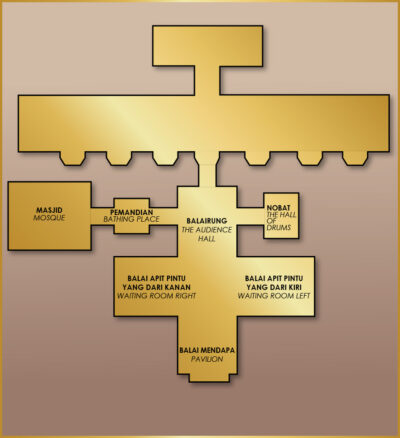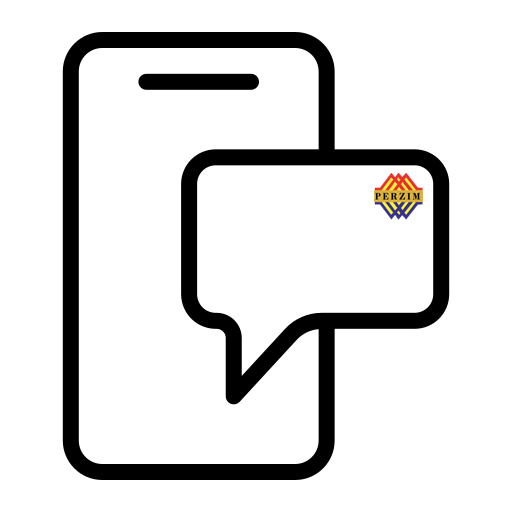MUZIUM ISTANA KESULTANAN MELAKA / MELAKA SULTANATE PALACE MUSEUM

MELAKA PALACE BUILDING TECHNOLOGY ILLUSTRATION OF MELAKA CITY, MELAKA SULTANATE PERIOD
In order to ensure the political stability and security of the government, the pattern of Melaka city’s urban settlement as well as its architecture plays a very important role. During the time of the Melaka Malay Sultanate, Bukit Melaka or Melaka Hill became the most elite area. According to Chinese and Portuguese reports, at its peak, the important institutions for the Sultanate’s administration was built with various types of halls such as the balairong seri, balai pendapa, balai nobat halls and other administrative spaces.
At the hillsides surrounding the main complex were built the houses of dignitaries and state officials. Around the foothills especially facing the waterfront and sea were the homes of the warrior chiefs, soldiers and the Orang Laut community. Apart from that lay other physical institutions such as mosques, warehouses and markets that played an important role in the activities and administration of the Melaka Malay Sultanate.
The book Sulalatus-Salatin (The Malay Annals) tells us about the characteristics of the building structure and the decorative features found in the palace of Sultan Mansur Syah that was built around 1465, as follows:
"As for the great palace, seventeen chambers, in each a space of three-three outstretched arms’ lengths in its vastness, the great columns sized of the arm’s hug, with seven ranks of its height above. In between the layered covers, there are given the transverse roofs of the ‘suckling elephant’ style; All of them with wings topped with the kite-type finials, all of them carved and canopied. Among the sculpted canopies were made also angled locust forms; the entirety painted with golden liquid. The peaks are of red glass that when exposed to the sun's rays, appear flaming like jewels. The walls of the palace are marbled swirls, thus they are plastered with large Chinese mirrors, when they are exposed to the heat of the sun their appearance is flaming; the glittering sparkles seemingly unreal to people's eyes. As for the beams of the palace are worth a cubit wide, and of handspan three fingers thick. The palace edge side is two cubits wide and one cubit thick, the carved palace door framing amounted forty in number, all painted with golden liquid. Beautiful thus is the work of the palace, not any other king's palace under this wind was like it in those days. The palace is what people called 'Mahligai Hawa Nafsu'; in copper and tin the roof is shingled.”
“So the Bendahara exerted the men to make the palaces and the halls. The Ungguran people made the great palace, the Sugal people another palace, and the Buru people a palace, and the Suir people a palace, and the Pancur Serapung people made the audience hall, the Sudir people made the frontage hall, and the Merba people made a cookery, and the Sawang people made a hall of officials on the side of the audience hall, the Kundur people made the side hall of the second door, and the Suntai people made the pantry hall, the Melai people made the bathhouse, the Upang people made the elephant stable, the Tungkal people made the mosque, the Bintan people made the palace fencing, the Muar people made the money fort (treasury). Indeed, the palace was better than that before. Thus, Sultan Mansur Syah stayed tranquil in the new palace forever more.”
PALACE OF THE MALAY KINGS
Role of the Palace during the administration of the Melaka Malay Sultanate:
- As the formal place of the court of the Sultan
- Centre of administration of the state
- Centre of focus for grand state ceremonies
- Centre of dissemination of information/knowledge
- Area of focused main activities for the literati and artisans
- Sultan / Sultan (King)
- Bentara Kanan / Right-Sided Court Herald
- Bentara Kiri / Left-Sided Court Herald
- Laksamana / Admiral
- Bendahara / Prime Minister
- Raja Muda / prince
- Hulubalang / Chief Warrior
- Penghulu Bendahari / State Treasurer
- Temenggung / Chief Police Officer
- Menteri-menteri (8 orang) / Ministers
- Shahbandar / Harbor Master
- Nakhoda / Captain of a Ship
- Sida-Sida / Courtiers
- Kadi / Religious Judge
- Fakih / Islamic Theologian
- Penghulu Balai / Palace Protocol Chief
- Pesalah Menanti Hukuman / Convict
- Utusan Raja Dinasti Ming / Envoy From Ming Court
- Utusan Bentara Majapahit / Envoy From Majapahit
- Pedagang India / Indian Traders
- Pembesar Pahang / Pahang Dignitary
![]()
